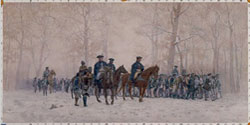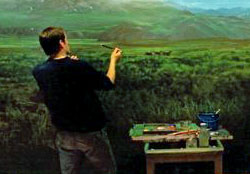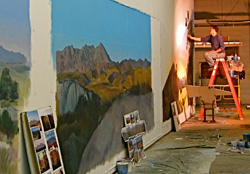| |
 |

|
 |
 |
 |
| |
Each mural shown on this website has been created in one of three basic ways. The most straightforward approach is direct painting on exhibit walls as shown in the first example below.
A second approach is to paint the murals full-scale on canvas
in the studio, then roll and ship them for installation. At the
mural site they are hung and glued on the wall with heavy-duty
paste.
|
|
A third approach, increasingly popular with museum clients, is to have scale-paintings scanned or photographed, then enlarged and digitally printed on fabric, or in some cases on vinyl wallpaper strips. Just as with full-scale canvas murals, finish painting can occur on the print after installation.
For all of the above approaches, preliminary sketches lead to
a final rendering that serves as a scaled model for producing
the finished mural. This gives the client a preview of the final
product.
|
|
|
 |
 |
 |
 |
| |
 |
|
| |
|
|
| |
DIGITAL PRINT FROM SCALE PAINTING
Advantages
- Large-scale bulk work is eliminated — stretching canvas, priming, sealing, etc., and production time is reduced.
- As technology improves, high resolution and color fidelity are becoming the norm. Artist and client can review sample prints before the mural is produced to ensure quality.
- Foreground detail can actually be painted at full-scale, directly on the print after installation. This leaves some wiggle-room for optimum placement after viewer sight-lines are experienced first hand, on location.
- The client owns an original painting that can be reprinted at any time — on canvas, panels or a variety of vinyl wallpapers. Prints on canvas or panels can be transported to other locations.
Things to Consider
- Extreme care must be taken with scale, especially with content like human figures, wildlife, and small items that must enlarge in exactly the correct proportion — a matter of fractions of inches.
- Using small brushes to achieve very tight detail can actually take as long or longer than using larger brushes at full-scale. Such detail must sustain resolution upon enlargement, without revealing distracting trace-marks.
- For murals that must link with 3D exhibits, hyper-awareness
of the exhibit layout (ground-forms, trees, architectural elements
and so forth) is essential, so that the painted elements will
match-up upon enlargement and installation.
|
|
|
| |
 |
 |
 |
| |
 |
|
| |
|
|
| |
PAINTING DIRECTLY ON THE WALL
Advantages
- The most direct approach — the mural takes shape in the space it will occupy.
- Very large murals can be created in one piece.
Things to Consider
- For large murals, the artist must be on site for long periods of time.
- Given that multiple projects are often in progress simultaneously, travel-costs can be significant.
- The mural is not movable unless the wall can itself be moved.
|
|
|
 |
 |
 |
 |
| |
 |
|
| |
|
|
| |
PAINTING ON CANVAS OR PANELS
Advantages
- The mural can be finished 80%-100% in the studio, saving travel costs.
- The mural venue is not occupied bY work-in-progress for long periods of time.
- The mural can be detached at a future date and moved.
Things to Consider
- Very large murals (over 15 feet high) usually must be done in sections, then seamed together on-site.
- For murals that serve as backdrops for three-dimensional exhibits, finish work — the final 10%-20% — must be done on-site to ensure optimum linkage, but this means far less time than if the whole picture were painted on-site.
|
|
|
|
|
|



